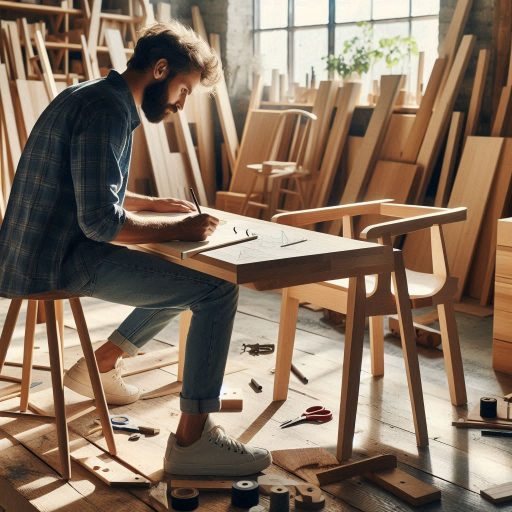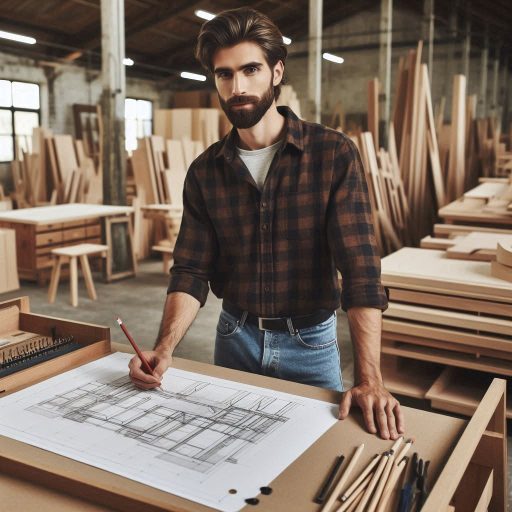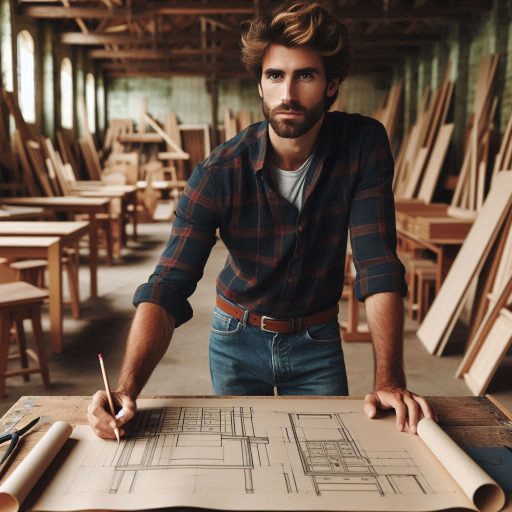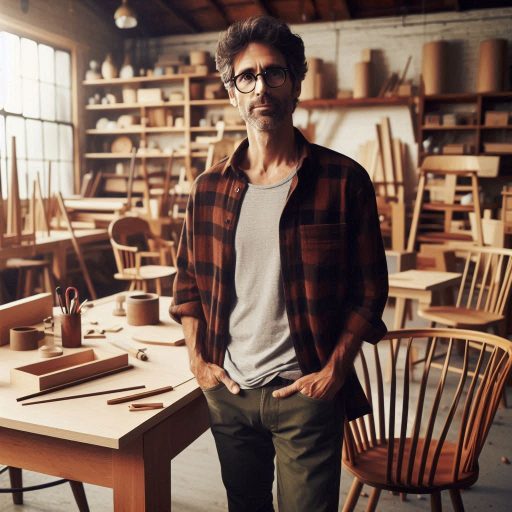Introduction
Furniture design is a captivating blend of creativity and functionality.
Designers work to create pieces that enhance living and working spaces while fulfilling practical purposes.
This field involves not only aesthetics but also a deep understanding of materials and construction techniques.
A successful career in furniture design requires a diverse set of skills that go beyond artistic talent.
Having the right skills is crucial for standing out in a competitive market.
Designers must possess a keen sense of style, an eye for detail, and the ability to think critically about design challenges.
Strong problem-solving abilities help address client needs and constraints.
They ensure every piece meets specific requirements and maintains visual appeal.
Key skills for furniture designers include creativity, technical knowledge, and effective communication.
Familiarity with design software is vital for visualizing concepts and presenting ideas to clients.
Additionally, understanding ergonomics is important for ensuring comfort and usability in designs.
By mastering these skills, aspiring furniture designers can craft innovative, functional, and beautiful pieces that resonate with clients.
We will delve deeper into these top skills and explore how they contribute to a successful career in furniture design.
Creativity
Creativity is an essential skill for anyone pursuing a successful career in furniture design.
It encompasses the ability to think outside the box, innovate, and generate unique ideas that differentiate your designs from others.
In a competitive market, creativity drives originality.
Designers craft pieces that meet functional needs and resonate emotionally with clients.
Importance of Creativity in Furniture Design
Creativity fuels the design process, inspiring designers to envision one-of-a-kind furniture pieces.
Without this spark of innovation, the world of furniture design risks becoming stagnant, lacking the fresh perspectives that breathe life into each creation.
Original designs have the power to evoke emotions, tell stories, and reflect personal styles.
They can turn functional items into works of art, elevating everyday living spaces into environments that inspire and delight.
Examples of How Creativity Can Set a Designer Apart
Innovative Use of Materials
Creative designers often experiment with various materials, textures, and finishes.
This exploration can lead to visually stunning and unexpected pieces that capture attention.
For instance, combining reclaimed wood with metal accents not only enhances aesthetic appeal but also promotes sustainability.
Such innovative use of materials can transform standard furniture into conversation starters.
Unique Design Solutions
Facing design challenges is a routine part of a designer’s journey.
Creative individuals excel at devising unconventional solutions.
When maximizing a small space, a designer creates multifunctional furniture.
For example, they might design a sofa that converts into a bed.
They may also craft a coffee table with built-in storage.
These unique solutions not only meet practical needs but also showcase the designer‘s ability to think critically and creatively.
Bold Aesthetics
Creativity allows designers to explore bold color palettes and unique shapes that challenge traditional norms.
Designers embrace daring aesthetics to create signature styles.
These styles appeal to niche markets and attract clients who value individuality and artistry in furniture.
Ways to Enhance and Develop Creative Skills
Seek Inspiration
One of the most effective ways to enhance creativity is to seek inspiration from diverse sources.
Visiting museums, art galleries, and design shows can expose you to different artistic movements, cultural artifacts, and innovative design trends.
Engaging with various forms of art broadens your perspective and enriches your design vocabulary.
Collaborate with Others
Collaboration is a powerful catalyst for creativity.
Working with other creative individuals, such as artists, architects, or craftsmen, can spark new ideas and insights.
By sharing perspectives and techniques, you can expand your creative thinking and discover new approaches to design challenges.
Practice Design Thinking
Embracing a design thinking approach can significantly enhance your creative problem-solving abilities.
This methodology emphasizes empathy, ideation, and iteration, allowing you to understand the needs of your clients deeply.
By focusing on user-centered design, you can generate innovative solutions that resonate with your audience.
Experiment and Iterate
Don‘t be afraid to experiment with your designs.
Create prototypes, gather feedback, and iterate on your ideas.
This process not only improves your designs but also fosters a mindset of continuous improvement and exploration.
Creativity is more than just a buzzword in furniture design it is a vital skill that shapes the industry.
By embracing creativity, designers can innovate, push boundaries, and produce exceptional work that resonates with clients.
It’s about finding unique solutions to design problems and transforming ordinary furniture into extraordinary experiences.
By actively developing and honing your creative skills, you can carve out a successful and fulfilling career in the dynamic world of furniture design.
Read: Top Skills Needed for Art Educators and Instructors
Technical Skills
In the field of furniture design, possessing strong technical skills is crucial for creating functional and aesthetically pleasing pieces.
Understanding materials and manufacturing processes is foundational.
Designers must know the properties of various materials, such as wood, metal, and fabric, to choose the right ones for each project.
This knowledge allows designers to create durable and appealing furniture that meets consumer needs.
Proficiency in software tools like Computer-Aided Design (CAD) is also essential.
CAD software enables designers to create precise and detailed designs, facilitating accurate visualizations and prototypes.
Mastering these tools enhances a designer‘s ability to communicate their ideas effectively to clients and manufacturers.
Moreover, familiarity with rendering software can help in presenting designs more attractively, making it easier to showcase concepts to stakeholders.
Staying up-to-date with new technologies and trends is vital in this ever-evolving industry.
As advancements occur rapidly, designers must continuously educate themselves about the latest materials, tools, and design philosophies.
Engaging with current trends not only keeps designers competitive but also allows them to align their work with market demands.
Knowledge of contemporary consumer preferences is essential for creating furniture that resonates with today’s buyers.
Importance of Staying Up-to-Date
The impact of technological advancements on furniture design cannot be overstated.
Innovations in materials and production techniques can significantly influence design choices.
For instance, sustainable materials and smart furniture solutions are gaining traction as consumers become more environmentally conscious.
Understanding these trends helps designers create pieces that meet current market expectations.
Furthermore, staying informed about the latest design trends and technologies helps designers maintain a competitive edge.
Knowing what is popular in the market allows designers to innovate while ensuring their work appeals to potential buyers.
Additionally, adopting new technologies can streamline design and production processes, enhancing overall efficiency.
This can lead to faster turnaround times and reduced costs, benefiting both designers and manufacturers.
Suggestions for Improving Technical Skills
To enhance their technical skills, furniture designers can take several proactive steps.
- Enroll in Courses or Workshops: Participating in educational programs enhances a designer‘s knowledge and skills.
These programs focus on new materials, manufacturing techniques, and software tools.
Many institutions offer specialized workshops that provide hands-on experience with the latest technologies. - Attend Trade Shows and Industry Events:Engaging with trade shows and exhibitions helps designers network with industry peers.
It also keeps them informed about the latest innovations.
These events often showcase the latest materials, designs, and technologies, providing valuable insights into emerging trends. - Collaborate with Colleagues or Mentors: Working alongside experienced professionals can offer invaluable insights.
Designers can learn from the expertise of their colleagues and mentors, gaining practical knowledge that enhances their skills.
This collaboration fosters an environment of creativity and innovation.
By actively enhancing their technical skills, furniture designers can create innovative and high-quality pieces that resonate with customers.
In a competitive market, designers stay ahead of trends by adopting new technologies.
This approach helps them deliver exceptional products.
They meet consumer needs and preferences effectively.
Read: Collaborating with Other Creative Roles
Communication Skills
Effective communication is paramount in furniture design.
Designers work closely with clients, suppliers, and team members to transform concepts into tangible products.
Without clear and concise communication, misunderstandings can lead to errors, delays, and unmet expectations.
Significance of Effective Communication
Building Strong Relationships with Clients
Understanding clients’ needs and preferences is the cornerstone of successful furniture design.
Effective communication enables designers to:
- Actively Listen: By engaging in meaningful conversations, designers can uncover specific requirements and desires.
- Ask the Right Questions: Inquiring about styles, materials, and functionality helps refine design ideas to align with client expectations.
- Foster Trust: Open dialogue builds rapport, making clients feel valued and understood.
Collaborating with Suppliers
Clear communication with suppliers is essential for the timely delivery of materials and adherence to quality standards.
Key aspects include:
Transform Your Career Today
Unlock a personalized career strategy that drives real results. Get tailored advice and a roadmap designed just for you.
Start Now- Conveying Requirements Accurately: Designers must articulate specifications precisely to prevent delays or discrepancies.
- Establishing Timelines: Clearly outlining deadlines helps ensure that all parties are aligned and that materials arrive when needed.
- Problem-Solving: Effective communication facilitates quick resolution of issues, minimizing disruptions in the design process.
Working with Team Members
Collaboration among team members is vital for successful project execution.
Effective communication enhances:
- Idea Sharing: A supportive environment encourages brainstorming and the exchange of creative ideas.
- Implementation: Clear communication ensures that everyone understands their roles and responsibilities, streamlining the design process.
- Feedback Loops: Constructive discussions enable teams to refine designs collaboratively and efficiently.
Importance of Strong Communication Skills
Presenting Design Ideas
Articulating design concepts clearly is crucial when presenting to clients or team members.
Strong communication skills allow designers to:
- Convey Vision Effectively: Designers can share their ideas in a compelling manner that resonates with the audience.
- Gather Constructive Feedback: Encouraging input fosters a collaborative spirit and leads to improved design outcomes.
- Enhance Persuasion: Clear articulation of ideas helps gain buy-in from stakeholders, ensuring project alignment.
Collaborating with Others
In collaborative environments, effective communication fosters:
- Cooperation Among Stakeholders: Keeping everyone informed ensures that all parties work towards a common goal.
- Conflict Resolution: Open lines of communication can help address misunderstandings before they escalate into larger issues.
- Shared Responsibility: Encouraging input from all team members promotes a sense of ownership and accountability.
Tips for Improving Communication Skills
Practice Active Listening
Listening attentively is crucial for gaining valuable insights from clients, suppliers, and team members.
By practicing active listening, designers can:
- Understand Perspectives: This fosters empathy, allowing for better alignment with stakeholders’ needs.
- Enhance Communication Effectiveness: Insightful responses based on what others share can lead to more meaningful conversations.
Provide Clear Feedback
Constructive feedback is essential for effective communication. Designers should:
- Be Specific: Clearly outline what works well and areas needing improvement to facilitate productive discussions.
- Encourage Dialogue: Open-ended feedback invites further conversation and exploration of ideas.
Use Visual Aids
Visual aids, such as sketches or mood boards, can significantly enhance communication.
They allow designers to:
- Bridge Communication Gaps: When words fall short, visuals can convey ideas more effectively.
- Ensure Alignment: Visual representations help ensure that all stakeholders are on the same page regarding design concepts.
Prioritizing communication skills in furniture design enhances collaboration, builds strong relationships, and ensures successful project outcomes.
Designers can navigate the dynamic field by improving their communication practices.
This focus enables them to deliver exceptional projects.
They can meet or exceed client expectations through effective communication.
Read: Breaking Down Iconic Movie Costumes
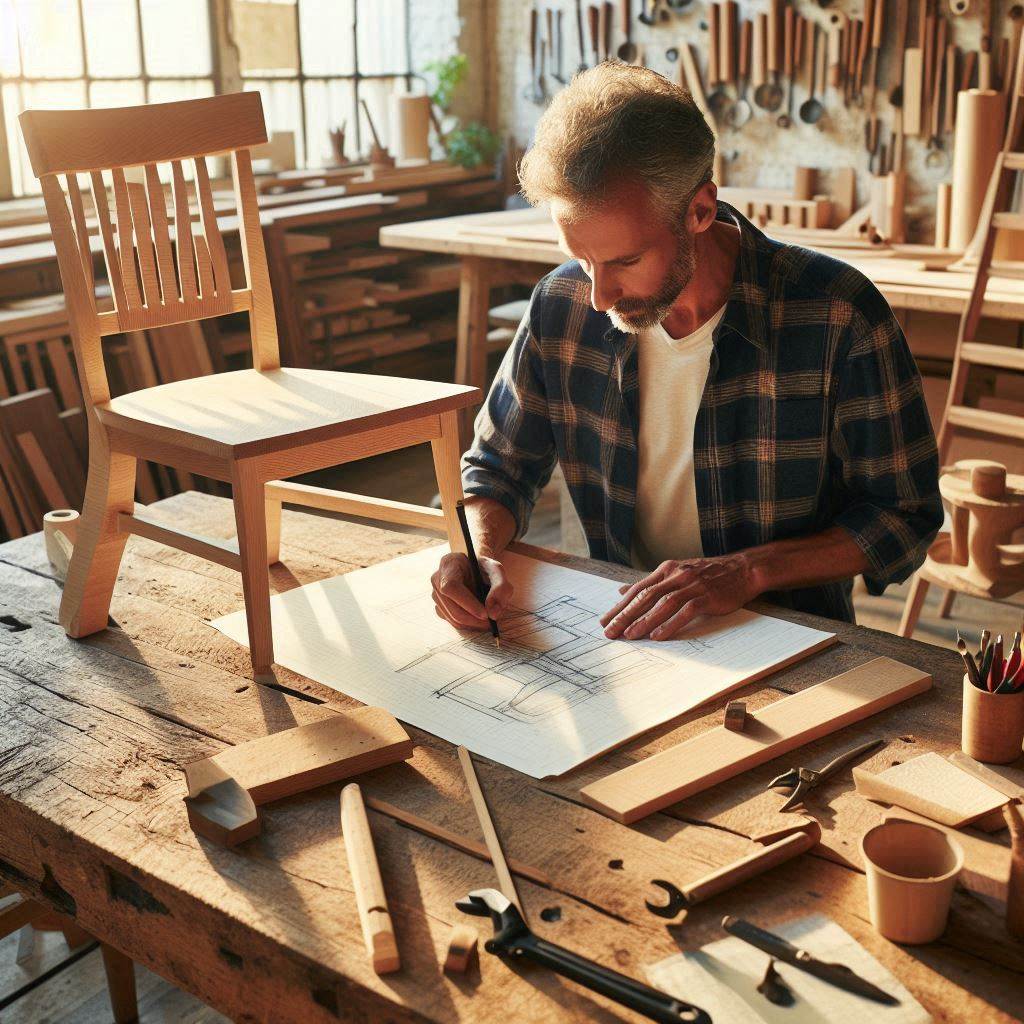
Attention to Detail
Attention to detail is crucial in furniture design.
It can significantly impact the final product’s quality and appeal.
Designers must focus on every aspect, from initial measurements to the finishing touches.
Here‘s why attention to detail matters and how to cultivate it.
Importance of Attention to Detail
- Precision in Measurements: Accurate measurements ensure that furniture fits well in intended spaces.
A slight miscalculation can lead to uncomfortable or unusable designs. - Quality of Craftsmanship: Fine details enhance the overall craftsmanship.
Smooth edges, even seams, and perfect finishes contribute to the aesthetic appeal. - Functional Design: Small design elements can greatly affect functionality.
For example, the placement of handles or hinges impacts ease of use. - Customer Satisfaction: Clients expect high-quality products.
Attention to detail builds trust and leads to repeat business and referrals.
Impact of Small Mistakes
Even minor errors can have significant consequences.
A misaligned drawer can frustrate users and diminish their experience.
Similarly, uneven finishes can suggest poor craftsmanship, affecting the product‘s marketability.
Here are some common mistakes that arise from a lack of attention to detail.
- Incorrect Dimensions: Furniture that doesn’t fit can lead to costly alterations.
- Inconsistent Materials: Using different wood types can create mismatched appearances.
- Poor Joinery: Weak joints can compromise furniture durability.
Strategies to Enhance Attention to Detail
Cultivating a keen eye for detail takes practice and discipline.
Here are strategies to help you improve:
- Create Checklists: Develop checklists for each design stage. Include measurements, materials, and finishing details.
- Use Technology: Employ design software with measurement tools.
This helps ensure accuracy before production begins. - Take Breaks: Step away from your work periodically.
A fresh perspective allows you to catch mistakes you might otherwise overlook. - Seek Feedback: Share your designs with peers or mentors. Constructive criticism can reveal overlooked details.
- Practice Mindfulness: Focus on the present moment while designing.
Mindfulness can enhance your ability to notice finer details. - Continuous Learning: Attend workshops or courses on craftsmanship and design.
Learning new techniques can deepen your appreciation for detail.
Attention to detail is vital for success in furniture design.
It influences precision, craftsmanship, and customer satisfaction.
By adopting effective strategies, designers can develop this essential skill.
Ultimately, a meticulous approach leads to superior furniture that delights clients and stands the test of time.
Read: Freelance vs. In-House Costume Design Jobs
Problem-solving skills
Problem-Solving Skills in Furniture Design
Successful career in furniture design.
Designers frequently encounter challenges that require innovative solutions.
Whether it‘s a design flaw or material limitations, effective problem-solving can elevate a project from ordinary to extraordinary.
Importance of Problem-Solving Skills
- Navigating Design Challenges: Designers often face unexpected obstacles during the design process.
These challenges may arise from client requests, budget constraints, or material availability.
A strong problem-solver can adapt designs to meet these demands while maintaining aesthetic and functional quality. - Creative Thinking: Creative thinking plays a crucial role in finding solutions.
Designers must envision alternative approaches and explore new ideas.
This creativity allows them to develop unique solutions that satisfy both functional and aesthetic requirements. - Complex Design Problems: Furniture design can involve intricate problems, such as balancing form and function.
Designers often need to consider ergonomics, sustainability, and cost-effectiveness.
Effective problem-solving helps navigate these complexities and leads to well-rounded designs.
Strategies to Hone Problem-Solving Skills
- Practice Critical Thinking: Engage in exercises that require critical analysis.
Analyze existing designs and identify potential improvements.
This practice enhances your ability to dissect problems effectively. - Collaborate with Peers: Working with fellow designers encourages the exchange of ideas.
Collaboration fosters a creative environment where different perspectives can lead to innovative solutions.
Embrace teamwork to enhance your problem-solving toolkit. - Take on Challenging Projects: Seek projects that push your limits.
Tackling more complex design challenges hones your ability to think on your feet.
Each experience strengthens your problem-solving capabilities. - Seek Feedback: Constructive criticism from clients and colleagues is invaluable.
Actively seek feedback on your designs and decision-making processes.
Use this input to refine your problem-solving approach. - Stay Informed: Keeping up with industry trends and new materials can enhance your problem-solving repertoire.
Knowledge of innovative solutions can inspire fresh ideas and alternatives.
Attend workshops, read design publications, and participate in online forums to stay updated.
Problem-solving skills are vital for furniture designers.
They empower designers to navigate challenges, think creatively, and find effective solutions.
By practicing critical thinking, collaborating with peers, and embracing feedback, aspiring designers can sharpen their problem-solving abilities.
Investing time in honing these skills will ultimately lead to successful and innovative furniture designs.
Delve into the Subject: Top Design Schools for Aspiring Product Designers
Time Management
Importance of time management in furniture design with deadlines and project timelines to meet
Time management plays a crucial role in furniture design.
Designers face tight deadlines and project timelines regularly.
Effective time management ensures that projects are completed on schedule and meet client expectations.
When designers manage their time well, they enhance their productivity and creativity.
Impact of poor time management on the quality of work and overall success in the field
Poor time management can severely impact the quality of work.
When deadlines loom, designers may rush through tasks.
This rushed approach often leads to mistakes, missed details, and subpar craftsmanship.
Additionally, clients may become dissatisfied, affecting future business opportunities.
Designers must prioritize their tasks to avoid these pitfalls.
Setting priorities is key to effective time management.
Designers should identify which tasks are most critical.
By focusing on high-priority items first, they can allocate sufficient time to complete them thoroughly.
Creating a to-do list can help visualize these priorities.
Each day, designers can check off completed tasks, providing a sense of accomplishment.
Another effective strategy is to create a detailed schedule.
A schedule allows designers to allocate specific time blocks for each task.
This method helps ensure that all aspects of a project receive adequate attention.
For instance, allocating time for research, sketching, and prototyping can lead to a well-rounded design process.
Utilizing project management tools can also enhance time management.
Software such as Trello or Asana allows designers to track progress and deadlines.
These tools provide visual representations of timelines, making it easier to stay on track.
Designers can also set reminders for critical milestones, preventing last-minute scrambles.
Tips for improving time management skills, such as setting priorities and creating a schedule
Regularly reviewing progress is vital for improving time management skills.
Designers should assess whether they are meeting deadlines and staying within budget.
If a project falls behind schedule, it‘s essential to identify the reasons.
By understanding these challenges, designers can adjust their approach and enhance their future time management.
Additionally, seeking feedback from colleagues can offer valuable insights.
Collaborating with other designers can reveal effective time management strategies.
Learning from others’ experiences helps designers refine their own methods.
This collaborative approach fosters a supportive environment that encourages growth.
Finally, practice makes perfect.
The more designers work on managing their time, the better they become.
Over time, they will develop routines that enhance their efficiency and creativity.
Ultimately, mastering time management empowers furniture designers to produce exceptional work consistently.
Time management is essential for success in furniture design.
By prioritizing tasks, creating schedules, and utilizing tools, designers can improve their time management skills.
This improvement leads to higher quality work and greater client satisfaction.
Find Out More: The Importance of Accessibility in UX/UI Design
Transform Your Career Today
Unlock a personalized career strategy that drives real results. Get tailored advice and a roadmap designed just for you.
Start NowConclusion
A successful career in furniture design requires several key skills that aspiring designers should focus on.
First, creative thinking is essential.
This skill allows designers to develop unique and innovative ideas that set their work apart from others.
Whether it’s through sketching or digital rendering, the ability to visualize concepts is crucial.
Next, technical proficiency in materials and construction is vital.
Understanding how different materials behave and how to construct pieces ensures functionality and durability.
Strong communication skills also play a significant role in a designer’s success.
Effective communication helps designers collaborate with clients, manufacturers, and other stakeholders.
It allows them to convey their vision clearly and understand client needs, leading to satisfying outcomes.
Additionally, staying updated on market trends is important.
Knowledge of emerging styles, consumer preferences, and sustainable practices keeps designers relevant and competitive.
It enables them to create pieces that resonate with today’s buyers.
Developing and honing these skills is essential for long-term success in the furniture design industry.
Continuous learning opens doors to new techniques, materials, and design philosophies.
Attend workshops, take online courses, or seek mentorship opportunities to expand your knowledge.
[E-Books for Sale]
The Big Book of 500 High-Paying Jobs in America: Unlock Your Earning Potential
$19.99 • 500 High-Paying Jobs • 330 pages
Explore 500 high-paying jobs in America and learn how to boost your career, earn more, and achieve success!
See All 500 High-Paying Jobs of this E-Book
1001 Professions Without a Degree: High-Paying American Jobs You Can Start Now
$19.99 • 1001 Professions Without a Degree • 174 pages
Discover 1001 high-paying jobs without a degree! Unlock career tips, skills, and success strategies for just $19.99!

